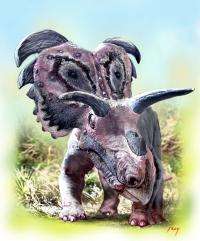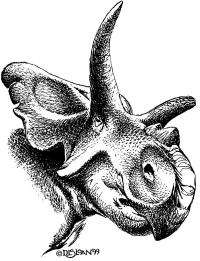Scientists announce new horned dinosaur

Michael J. Ryan, Ph.D., a scientist at The Cleveland Museum of Natural History, has announced the discovery of a new horned dinosaur, Medusaceratops lokii. Approximately 20 feet long and weighing more than 2 tons, the newly identified plant-eating dinosaur lived nearly 78 million years ago during the Late Cretaceous period in what is now Montana. Its identification marks the discovery of a new genus of horned dinosaur.
Ryan, curator and head of Vertebrate Paleontology at the Museum, published his findings on the new genus in the book, "New Perspectives on Horned Dinosaurs: The Royal Tyrrell Museum Ceratopsian Symposium," available from Indiana University Press. Ryan was the book's lead editor.
Medusaceratops belongs to the Chasmosaurinae subfamily of the horned dinosaur family Ceratopsidae. The other subfamily is Centrosaurinae. The specimen is the first Campanian-aged chasmosaurine ceratopsid found in Montana. It is also the oldest known Chasmosaurine ceratopsid.
The new dinosaur was discovered in a bonebed on private land located along the Milk River in North Central Montana. Fossilized bones from the site were acquired by Canada Fossil, Inc., of Calgary, Alberta, in the mid-1990s. The company consulted with Ryan and his colleagues to identify material from the site. At first, the scientists could not make a positive identification.
Medusaceratops had giant brow bones more than 3 feet long over each eye, and a large, shield-like frill off the back of its skull adorned with large curling hooks. Medusaceratops lokii means "Loki's horned-faced Medusa," referring to the thickened, fossilized, snake-like hooks on the side of the frill. It was named after Loki, the Norse god of mischief, because the new dinosaur initially caused scientists some confusion.

"At first we couldn't figure out what we had," said Ryan. "Some of the material looked as if it came from a form related to Centrosaurus, a centrosaurine noted for having short brow horns. The rest of the pieces had giant brow horns similar to Triceratops, a chasmosaurine. That's one of the problems with bonebeds—even though you can collect a large amount of material, much of it is broken and all of it is disarticulated, so the story is rarely clear cut."
Eventually Ryan found a complete articulated skull of a centrosaur with long brow horns in southern Alberta of what appeared to be the new animal from Montana, and named it Albertaceratops in 2007. At that time, he assumed he was looking at a stray that had literally crossed the international border millions of years ago.
After reexamining the Montanan material more recently, Ryan realized that at least some of the material in the Montana bonebed was not Albertaceratops. Some of the elements were much larger than any other horned dinosaur from the same time period, including Albertaceratops. And even though Albertaceratops and Medusaceratops are superficially very similar, the shape and number of the hooks and ornaments along the edge of the frill actually puts them in separate horned dinosaur groups, with Medusaceratops being a chasmosaur.
"Although the ornamentation on the frill is pretty spectacular, it probably was not used for defense against predators; rather it was more likely prehistoric "bling" used to attract a mate," said co-author Anthony Russell, Ph.D., professor of biological sciences at the University of Calgary in Alberta.
"Medusaceratops is the oldest member of the Chasmosaurinae in North America and shows that the group, like its most famous member, Triceratops, had long brow horns and were fairly large when they first evolved," said Ryan. "But later chasmosaurs that are just a bit younger than Medusaceratops tend to have much shorter horns and have much smaller, lighter bodies.
"Here we have something almost the size of Triceratops, but 10 million years before it lived," Ryan said. "T. rex was not around yet, so what was Medusaceratops squaring off against? That's one of the things we're now looking for in Alberta."
Provided by Cleveland Museum of Natural History




















